Related Research Articles

The geometer moths are moths belonging to the family Geometridae of the insect order Lepidoptera, the moths and butterflies. Their scientific name derives from the Ancient Greek geo γεω, and metron μέτρον "measure" in reference to the way their larvae, or inchworms, appear to measure the earth as they move along in a looping fashion. A very large family, it has around 23,000 species of moths described, and over 1400 species from six subfamilies indigenous to North America alone. A well-known member is the peppered moth, Biston betularia, which has been subject of numerous studies in population genetics. Several other geometer moths are notorious pests.

Geometrinae is the nominate subfamily of the geometer moth family (Geometridae). It is strongly split, containing a considerable number of tribes of which most are presently very small or monotypic. These small moths are often a light bluish green, leading to the common name of emerald moths, though a few species called thus are also found in the tribe Campaeini of the Ennominae. In 2018, a phylogeny and classification based on a molecular phylogenetic analysis was published in the Zoological Journal of the Linnean Society in which 13 tribes were accepted.
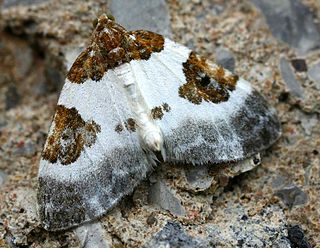
The Cidariini are the largest tribe of geometer moths in the subfamily Larentiinae. The Cidariini include many of the species known as "carpets" or, ambiguously, "carpet moths", and are among the few geometer moths that have been subject to fairly comprehensive cladistic study of their phylogeny. The tribe was described by Philogène Auguste Joseph Duponchel in 1845.
Anchiphyllia is a genus of moths in the family Geometridae erected by Arthur Gardiner Butler in 1893. It is considered by Luis E. Parra and Carla A. Alvear to be a synonym of Ennada.
Astalotesia is a monotypic moth genus in the family Geometridae. Its only species, Astalotesia bucurvata, is found in the US state of Texas. Both the genus and species were first described by Douglas C. Ferguson, André Blanchard and Ed Knudson in 1983.

Drepanulatrix is a genus of moths in the family Geometridae.

Eois is a genus of moths in the family Geometridae. The genus contains about 250 validly described species, most from the Neotropical region. Many species are still undescribed and the total number of species is estimated to be over a 1,000 in the Neotropical region alone. The genus was first described by Jacob Hübner in 1818.
Erosina is a genus of moths in the family Geometridae erected by Achille Guenée in 1858.
Glaucina is a genus of moths in the family Geometridae erected by George Duryea Hulst in 1896.

Glenoides is a genus of moths in the family Geometridae described by James Halliday McDunnough in 1920.
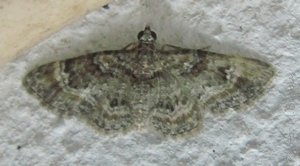
Gymnoscelis, the pugs, is a large genus of moths in the family Geometridae described by Paul Mabille in 1868.
Honorana is a monotypic moth genus in the family Geometridae. Its only species is Honorana notaturia. Both the genus and species were first described by Blanchard in 1852.
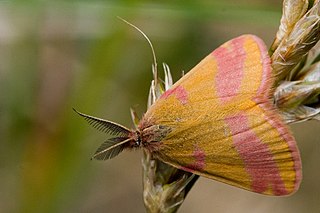
Lythria is a genus of moths in the family Geometridae erected by Jacob Hübner in 1823. It is the only genus of the monotypic tribe Lythriini described by Claude Herbulot in 1962.
Mallomus is a genus of moths in the family Geometridae.
Phyllia is a monotypic moth genus in the family Geometridae. It is considered by Luis E. Parra and Carla A. Alvear to be a synonym of Ennada. As a genus, its only species is Phyllia triangularia, which is found in Chile. Both the genus and species were described by Blanchard in 1852.

Sterrhinae is a large subfamily of geometer moths with some 3,000 described species, with more than half belonging to the taxonomically difficult, very diverse genera, Idaea and Scopula. This subfamily was described by Edward Meyrick in 1892. They are the most diverse in the tropics with the number of species decreasing with increasing latitude and elevation.
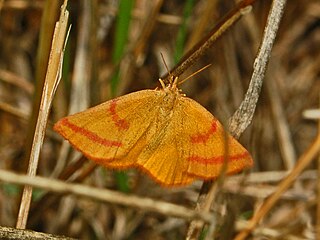
Lythria purpuraria, the purple-barred yellow, is a species of moth of the family Geometridae. It is found from western Europe to Siberia, Russia, Ukraine, Turkmenistan and Kazakhstan.
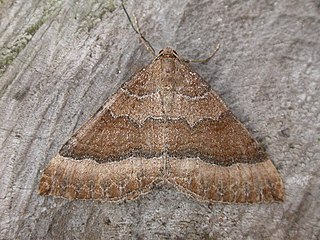
Larentiini is a tribe of geometer moths under subfamily Larentiinae. The tribe was first described by Philogène Auguste Joseph Duponchel in 1845.
Louis Beethoven Prout (1864–1943) was an English entomologist and musicologist.

Eupithecia quadripunctata is a moth in the family Geometridae. It is found in India, Pakistan, Nepal, Russia, China, Taiwan, Korea, Japan and northern Thailand.
References
- Revision of the genus Ennada Blanchard (Lepidoptera:Geometridae), 2009
- Ennada at Markku Savela's Lepidoptera and Some Other Life Forms
- Natural History Museum Lepidoptera genus database